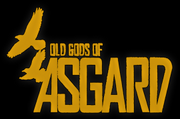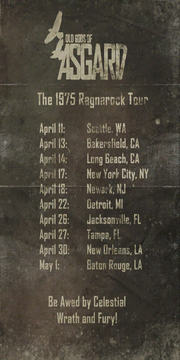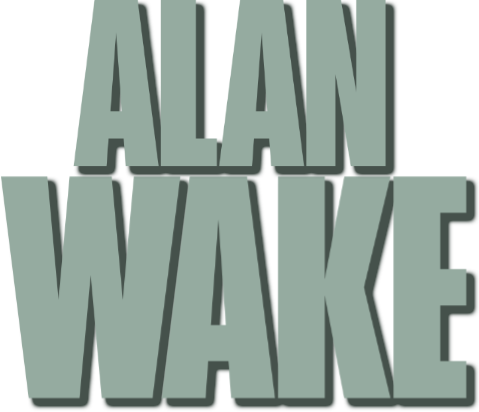
The Old Gods Of Asgard are a rock band that appear in the Alan Wake universe. Two of its members are known as the Anderson Brothers. The real name of the band who write and play the songs for the game are Poets of the Fall.
History
The Anderson brothers founded the band in 1971. While both had already been professional musicians for several years, their careers had been less than successful, mostly because – as the duo believed – they lacked the formidable stage presence of other, more successful bands.
In a bid to achieve more popularity, and influenced by their Scandinavian heritage, they co-opted the identities of Norse Gods for their stage personas, going so far as to legally change their names. It’s fair to say that the Andersons weren't scholars, and especially in the beginning, this was little more than a gimmick, but the new personas were spot on, and as the band gained momentum got more comfortable with these roles, they became an irrevocable part of their lifestyle and public image.
Odin Anderson was the band’s leader and co-founder. He wasn't the most flamboyant figure, but it's fair to see that he was the driving force behind Old Gods of Asgard. This fit well with his namesake, as in the myths, the wise Odin was the All-Father, ruler of Asgard, the home of the Gods.
Odin's brother Tor co-founded the band with him. His new name referred to Tor (even though he preferred the original spelling), the hot-tempered god of thunder whose mighty hammer and gigantic strength featured in many old stories. It was a good fit for Tor Anderson, whose energetic drumming and often unpredictable mood swings – as well as his well-known unwillingness to back down from a fight – soon became the stuff of rock’n’roll legends. On the other hand, Tor’s persona exemplifies the way the Old Gods were willing to overlook certain details: in the legends, Tor is Odin's son, not his brother.
The duo next found “Fat” Bob Balder who, despite his nickname, was actually a very lithe man. In the Norse myths, Balder was associated with beauty, love and happiness – all qualities that fit Fat Bob tremendously well. Not only did his hippie roots predispose him towards a certain tender sensibility that made him very popular with women, he was also a calming influence on the often tumultuous band.
And finally, there was Loki – in retrospect, perhaps not the wisest choice of identities, given that in the Norse myths, he’s a malicious and cunning character known for his tricks. On the other hand, from all accounts it fit Loki Darkens perfectly, who was constantly at odds with his band mates. Loki went missing after the release of their second album, the 1972 Follow Me Underground.
Despite the loss of Loki’s considerable guitar skills, it’s clear that without him, the band functioned better. During the next six years Old Gods of Asgard released four fairly successful studio albums, bringing the total up to six. Megastardom on the level of some of their contemporaries eluded them, but the sales were consistently good and the band was in constant demand. A great deal of this success came from the carefully crafted image Old Gods of Asgard and their material – a curious mix of heavy rock, Norse myths, strange urban legends and fantasy – presented, and their bona fide hits, like “The Poet and the Muse” (The Black Rider Cometh, 1976) and “Children of the Elder God” (In the Valley of My Shadow, 1978) earned them mainstream popularity.
A seventh album was in the works, but was never released after the unfortunate demise of Fat Bob before the recording was complete. After his death, the Andersons retired to the small town of Bright Falls, Washington, where their old family farm had long served as the band’s headquarters.
The Old Gods never quite gained the worldwide recognition they hoped for, but for almost a decade, they enjoyed a successful career and maintain a solid cult following among rock’n’roll connoisseurs to this day.
Members
Taken from the Old Gods of Asgard Website
Odin Anderson
Odin was the group’s central figure, responsible for writing almost all of the band’s songs and known for his authority among the rest of the group. In addition to the material, Odin came up with the “Old Gods” image. He was well-known for the degree of control he wielded over the band, which was an occasional source of strife within the group. Unlike the other members, Odin was never very comfortable in the limelight: as a guitar player, he preferred impeccable technique over flamboyant displays of skill (although he was certainly capable of the latter when required), and he preferred to do his most important work behind the scenes. Odin can be seen with an eye patch on his right eye; in Norse mythology, Odin sacrificed one of his eyes to gain the Wisdom of Ages.
Tor Anderson
The charismatic Tor Anderson was known for the relentless energy he brought into the band, whether it was performing, partying or arguing. He was the figure many people most readily associated with the band, if only because he had the biggest physical presence. Easily angered but quick to laugh, Tor was known both for his habit of getting in trouble and his willingness to make up for it afterwards, and he never avoided a chance to be the center of attention.
"Fat" Bob Balder
Fat Bob was well-known for his friendly and open demeanor, and he was an extremely well-liked man. Despite being a former flower child who never quite managed to accept that the Summer of Love had ended, he was nevertheless not a naive man. It’s often said that Fat Bob Balder was the glue that held the band together; his presence had a calming effect on the volatile Tor, he smoothed things over with the capricious Loki, and he was the right-hand man for Odin. It’s certainly true that with his absence, the Old Gods fell apart. Fat Bob was diagnosed with leukemia and died in 1980, and the band never recovered from that loss: the promised new record was quietly scrapped. He seems to be the only band member that didn't change his name to that of a Norse god, at least until you realize that Balder is the name of a Norse god.
Loki Darkens
Loki was an excellent and inspired guitar player, but his behavior was a constant source of friction in the band: he would blow off practice sessions, and he had a reputation for uncaring, even cruel behavior. What’s more, he was undependable. Loki would often blow off practice sessions or disappear without letting the others know where he was, and there were numerous public arguments about money. It’s rumored that he was on the verge of getting fired from the band because the other Old Gods were sick of his antics, but he was still a considerable presence on the first records, and many fans enjoyed the unpredictable quirks he brought to the band’s sound. Loki’s current whereabouts are unknown, as he disappeared under unclear circumstances shortly after the release of Follow Me Underground.
Known Songs
| # | Name of Song | Length | Found In |
| 1 | The Poet and the Muse | 4:17 | The Truth |
| 2 | Children of the Elder God | 3:37 | The Truth |
| 3 | Balance Slays the Demon | 5:15 | Alan Wake's American Nightmare |
Discography

The record cover to "In the Valley of My Shadow"
Below are a list of albums they released in the 1970's, although the songs on them are unknown.
- The Memory of the Slaughter (1971)
- Follow Me Underground (1972)
- Alone at My Own Wake (1973)
- The Unraveling of Reason’s Skein (1975)
- The Black Rider Cometh (1976)
- In the Valley of My Shadow (1978)
1975 Ragnarock Tour

The poster with all the dates.
In 1975, the Old Gods of Asgard had a tour around America. Below are a list of dates of when they were. These dates can be found in Episode 4: The Truth. Below the dates, there is also a slogan:
"Be Awed by Celestial Wrath and Fury"
| Day | Date | Where | State |
| Friday | 11 April | Seattle | WA |
| Sunday | 13 April | Bakersfield | CA |
| Monday | 14 April | Long Beach | CA |
| Thursday | 17 April | New York City | NY |
| Friday | 18 April | Newark | NJ |
| Tuesday | 22 April | Detroit | MI |
| Saturday | 26 April | Jacksonville | FL |
| Sunday | 27 April | Tampa | FL |
| Wednesday | 30 April | New Orleans | LA |
| Friday | 1 May | Baton Rogue | LA |
Trivia
- The birds in their logo are their ravens, Memory and Thought, who were taken by the Dark Presence. Later in life, they investigated Alan while he wrote Departure.
- Poets of the Fall, the singers/writers of the songs, also make a small appearance in the game on The Harry Garrett Show.
- Alan has met the two of the remaining members of both the Old Gods of Asgard and Poets of the Fall.
- When the Poets of the Fall get played on the radio, Pat Maine remarks that they remind him of the Old Gods of Asgard.
- The name of the band refers to the recurring theme of Scandinavian mythology in Remedy games. Asgard is the home of the Scandinavian gods such as Odin, Tor, Loki, and Freyr.
- The band is another link between the games Alan Wake and Max Payne. The main villain of the first Max Payne, Nicole Horne, headed a company named the Aesir Corporation from her headquarters, the Asgard building. One of the main protagonists, Woden (the Germanic name for the god Odin), has one eye and seemingly infinite wisdom, drawing on the mythical Odin. Finally, the Poets of the Fall performed "Late Goodbye", a song featured in Max Payne 2: The Fall of Max Payne.
- The band apparently achieved a gold selling record. Their gold record can be seen in their dining room at the Anderson's farm.
- By the Chronology of The Old Gods of Asgard to Thomas Zane and Alan Wake having them be the first to be touched by the lake, and with the link of the song 'The Poet and His Muse' to the games events, along with how Zane most likely wrote in Alan Wake, it can be argued that they, in turn, created Zane and the events surrounding Bright Falls. The lady of the light, the muse, the witch, the cabin, etc., are all mentioned in their song, and the songs happened prior to all these.
